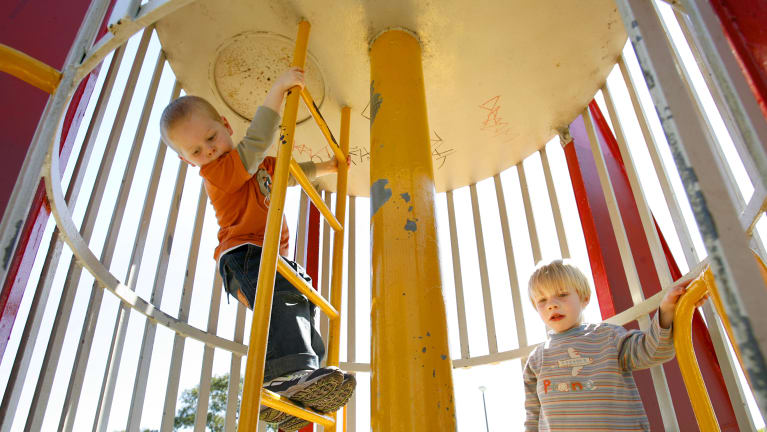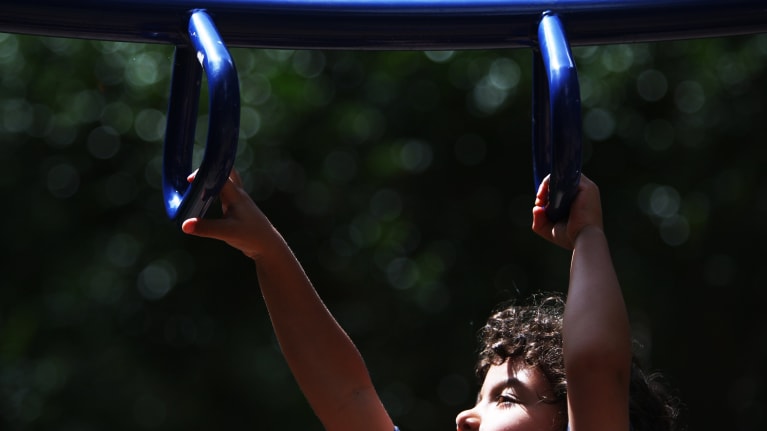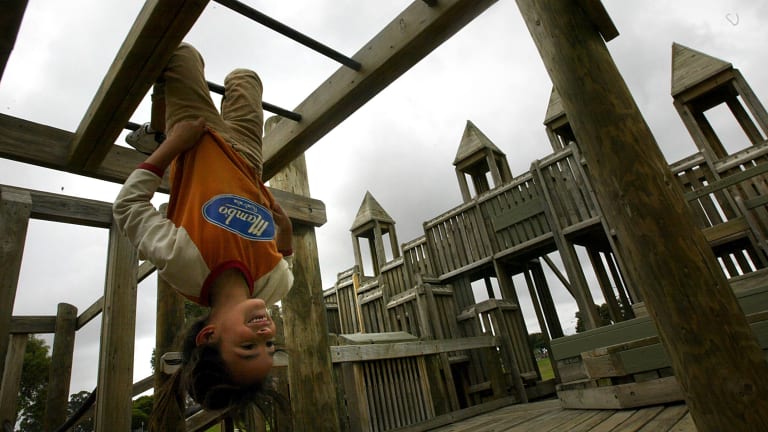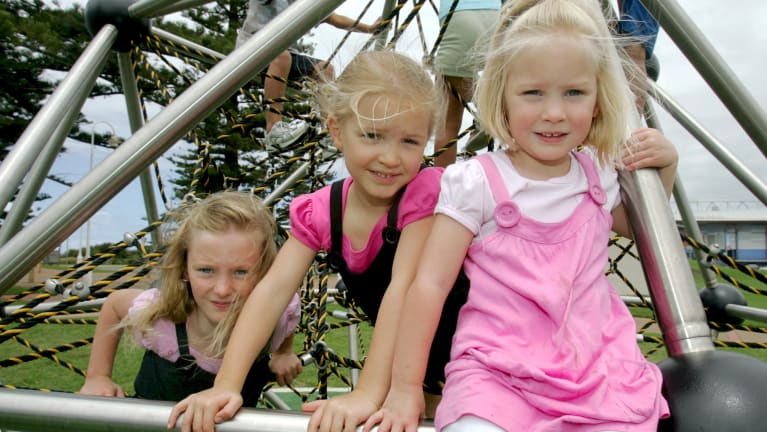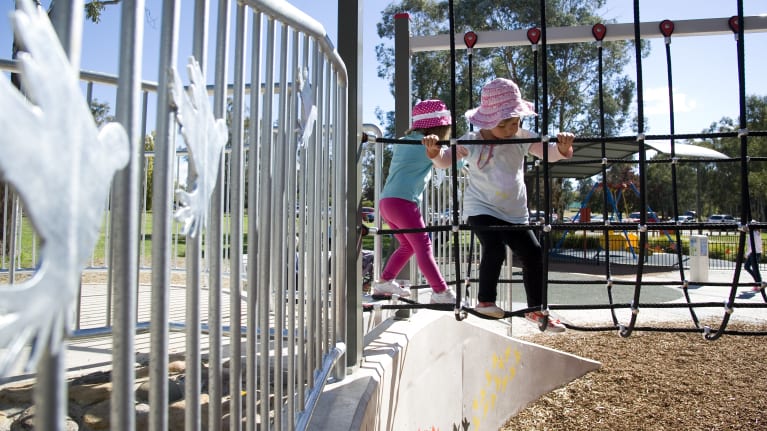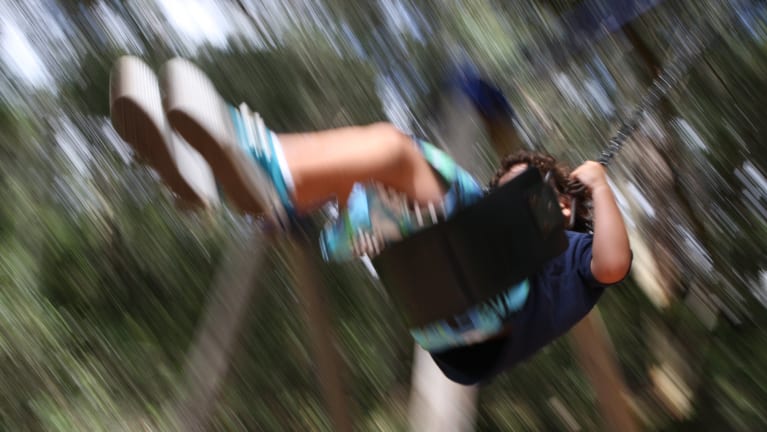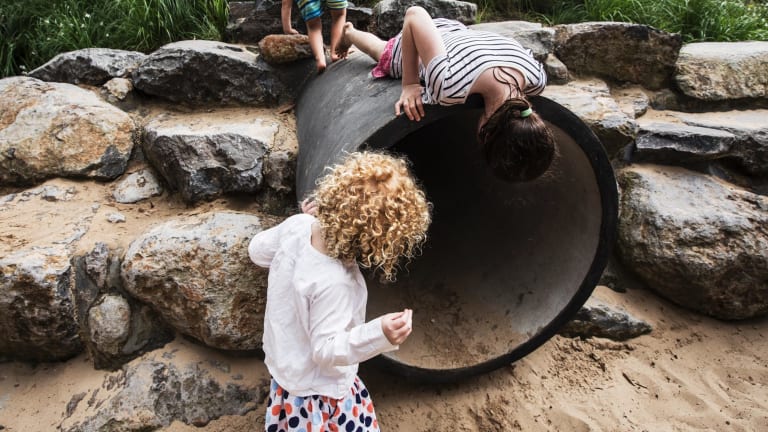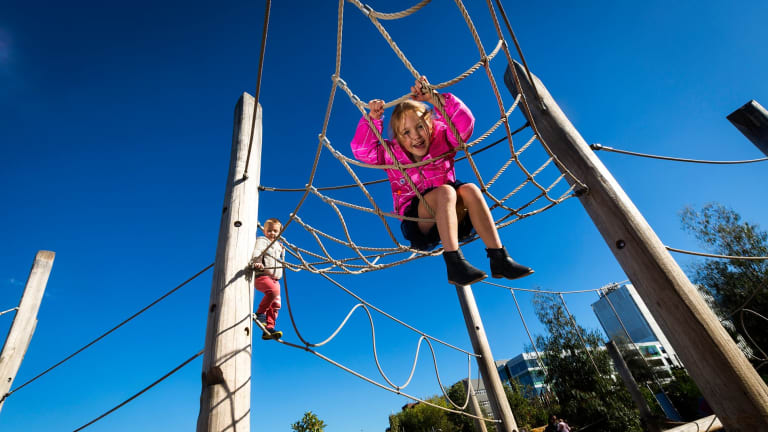Cotton wool club: are we right to remove risk from playgrounds?
My kids really loved the St Kilda Adventure Playground. Then management started taking things away.
We used to fly down the concrete ramp on a billy cart and bang into a wall of tyres at the end. The ramp’s still there, but the cart is gone. Last October the flying fox bit the dust too, after some “safety incidents”. Our desire to hang out there has waned.
Enmore Park in Marrickville, Sydney, 2006: the top levels of the rocket ship are sealed off for safety reasons.
“I don’t want to go to the adventure playground any more. Because it’s not an adventure. It’s boring,” says my eldest daughter, who just turned 12.
Far from being novel, our local experience is part of a decades-long trend towards the eradication of risk and greater safety in playgrounds that, on the surface, seems laudable. Few, after all, would bring back those dreaded monkey bars perched over concrete.
But there are rumblings we’ve gone too far.
In Britain, Office for Standards in Education chief inspector Amanda Spielman told an early education conference in November that “we don’t expect you to take away the climbing frame in case someone falls” and voiced her concern that we’re “creating overly risk-free environments”.
Beneath those concerns lie disturbing doubts. Is our push to remove risk really making kids any safer at all? Could we in fact, insidiously, be harming them?
Psychology professor Ellen Sandseter.
“I think we are. I think we are hampering their development,” says Ellen Sandseter, professor of psychology at Queen Maud University in Trondheim, Norway.
It’s a startling claim, but one backed by mounting evidence.
“We know that children doing more risk-taking play have a higher self-confidence … risky play can have an anti-phobic effect. Psychologically it can make you more robust, more resilient,” she says.
Sandseter’s claims stem from two theories. A basic in phobia treatment, fear of heights for example, is not to avoid heights but to face them in a controlled and graded way, something that can stamp out fear.
Understanding that, it’s not surprising that children who suffer falls from a height between the ages of five and nine are less likely to be scared of heights as adults. It also makes sense that if you want to get good at something risky – climbing, balancing, swinging, whatever – you have to practice it.
A Belgian study published last year found four to six-year-olds given a three-month crash course in doing risky stuff, such as climbing and jumping from crate to crate, were better able to detect and handle risk afterwards.
And a study involving Macquarie University published this year found mums and dads who adopt “challenging parenting behaviour” – pushing their tackers to take risks rather than holding them back – are raising less anxious kids.
But if risk is so good, why are we taking it away?
Nothing ventured: children allowed to experience risk will handle and detect it better.
The elephant casting a shadow over playgrounds is a complex beast, but the push to minimise litigation is a big part of its anatomy.
“It’s all about getting risk down to the lowest possible number,” says Peter Rozen, a barrister who lectures in workplace health and safety at Melbourne Law School.
In the workplace, where risk has little to no benefit, that is precisely what you want. But if risk is part and parcel of healthy play could governments, perhaps on the advice of legal teams and insurers, be applying over-rigorous workplace standards to the playground?
“I'm sure that occurs, and the approach of lawyers and insurers would necessarily be informed by that workplace paradigm because historically that has been their focus,” says Rozen.
That approach, however, sits uneasily with law reforms dating back to 2002 that aim to limit personal injury claims and make it easier to offer risky things up to the public.
Burden Park in Springvale, Melbourne, in 2003.
Back then, Australia was in the midst of an insurance crisis, with ballooning public liability premiums putting hundreds of organisations out of business, from footy clubs to trail ride operators. The Ipp Review prompted legislation that raised the bar for injured people wanting to sue.
“Prior to that if you had an accident you just knocked on the door of the organisation with the deepest pockets, which was by and large the council,” says David Eager, professor of risk management and injury prevention at the University of Technology Sydney.
These days you have to prove the operator is negligent, failing in its duty of care to take reasonable precautions to prevent injury. A much bigger ask. But the changes go further.
The law now takes into account the “social utility” of the risky activity. In other words, if it’s a “good” risk (think a slightly scary swing bridge with no rails) it is much harder to sue someone for not having prevented it.
Risk management expert David Eager.
“In the workplace we have zero tolerance to accidents. When kids are at play it is not a workplace so it is not a zero-tolerance affair,” says Eager. “What we want is for the kids to be able to make mistakes. Because they learn by making mistakes.”
Accordingly, Eager, who chairs the committee that developed Australia’s latest standards for playground equipment and surfacing, released in August 2017, built into them a need to gauge “good” risk.
“[Playground] operator(s) shall also take into account … the need for benefit assessment procedures instead of standard risk removal,” they read.
That might not seem earth-shattering but it copped a mention in a recent New York Times piece, placing Australia alongside Sweden and Canada in the vanguard of change. Indeed, Eager cuts something of a maverick figure in the often staid world of the safety engineer.
He has overseen changes, which came into effect in 2014, allowing designers to let kids climb to 3 metres, up from 2.5 metres, above fall-breaking surfaces such as bark. You can now also fall 600 millimetres onto a hard surface which, for busloads of kids, gives the green light to fun.
‘Play is not a wokplace’: Lang Park in Wollongong, 2008.
“Landscape architects and psychologists were telling us children need exposure to dry creek beds, boulders and sand, jumping from this rock to that rock, or that little log to the next one,” says Eager.
“You get people saying, ‘Oh Gee. A kid could trip and fall on that and they’ll say, ‘We can’t do that.’ What we’re saying in the playground standard is yes you can … we give you licence.”
It is a licence, however, that butts up hard against a safety culture in which any injury is bad, not merely the price of learning through play. The tagline of the US National Safety Council, for example, reads, “playgrounds don’t have to hurt”.
But Sandseter thinks we need to look closely at what is causing the pain.
Kambah District Park in the ACT, 2013.
“It is very important to distinguish risk from hazard. Hazards are hidden dangers that children are not capable of assessing or being aware of,” she says.
Last July, Fairfax Media reported the case of seven-year-old Phoenix Clucas, who was strangled and nearly died when her necklace caught on a spiral slide and acted as a noose. No one argues against rooting out and eliminating such hazards.
“But when children take risks with intent, and they are actually doing it in their play and they are doing it voluntarily, we should let them do that,” says Sandseter.
She also points out a disturbing paradox when it comes to kids and risk.
“I’ve seen a lot of examples of boring playground equipment. It is supposed to be safe, but it is so boring that children start to use it in a way the manufacturer hasn’t intended,” says Sandseter.
It’s called “risk compensation”. Fed-up kids will, for example, get their kicks climbing onto the roof of the house at the top of the slide, which can quickly turn the feature into a hazard.
Sandseter has just co-authored a chapter on risky play in a book published by the prestigious MIT Press. It is called Pseudoscience: The Conspiracy Against Science. So where is the shonky science in playgrounds?
“Total injury rates have not decreased after regulation of play was introduced,” the authors write. “Safety measures may well have made parents and authorities feel safer without doing anything for children’s safety.”
Flying high: ‘Safety measures may well have made parents and authorities feel safer’.
It’s a claim that goes against all intuition, not unlike the findings of a small but fascinating study conducted in the Parish School in Houston, Texas, published in February.
The researchers split nearly 600 students into two play groups and watched them for five years. One group got an off-the-rack playground from the catalogue. The other group lucked out with a ramshackle adventure playground complete with fort, loose tyres, reclaimed timber, saws, hammers and buckets of paint. Each group recorded over 200,000 hours of play.
The hurt tally? Nine serious injuries. Seven from the “safe” side and just two from the "adventure" side.
How could wilder possibly be safer than milder?
“When things are looking risky, more dangerous, and you feel more exposed, you are more cautious. You are more concentrated and more aware of what you are doing,” says Sandseter.
There is also, according to Sandseter, another playground myth in circulation.
“The knowledge that seems to spread that playgrounds are dangerous is not true. There is no science that actually can support that,” she says.
Her book chapter includes a sobering graph. It tots up the number of sporting injuries presenting to emergency departments per 100,000 hours of play. Rugby tops the table at 290. Soccer is second at 130. Public playgrounds? They fit snugly between fishing and sailing with a measly four injuries.
Kids play in the Ian Potter Children’s Wild Play Garden in Centennial Park, Sydney.
So why are we so focused on play equipment safety?
“There is an asset that can be linked to an accident,” says Eager. Get hurt in a standard footy field tangle and it’s often hard to know who’s at fault. Injuries from play kit track a more direct course back to manufacturers and operators, making them understandably risk-shy.
According to Sandseter, manufacturers (who occupy one of 13 seats on Eager’s committee) also have a glaring conflict of interest. In order to conform to tighter safety standards they have to make new equipment, all good for the bottom line.
None of which makes the view from the doctor’s chair any less disturbing.
A major report released last year found injury is the leading cause of death in Australian children, leading to hospital costs of over $2 billion in the decade to 2012. The most common injury mechanism was falls (38.4 per cent), most often from playground equipment (8.3 per cent), with over 56,000 recorded during the study period. The authors were so worried they called for a new injury prevention plan to protect Australian children.
“We need to be very careful about the assumptions and the recommendations that are being made on these injury statistics,” says Helen Little, a senior lecturer in the Department of Educational Studies at Macquarie University.
“Is it actually playground equipment in a park that has been constructed to meet the standards? Or is it stuff that a parent has gone and bought at Kmart and put up – a play gym for example – in the backyard?” she asks.
The report finds, in fact, that most injuries (24.5 per cent) occur at home, with less than 10 per cent happening in schools and public areas.
It’s worth noting, too, that Aussie kids got a D- on their 2016 physical activity report card, with less than one in five doing the recommended 60 minutes daily. That problem, says Little, is not helped if playgrounds get so boring that kids won’t go there.
“We are seeing children who are getting through primary school without having mastered some of the core fundamental movement skills such as jumping, kicking, throwing, catching,” she says.
One issue is that playground operators have leeway in what risk they choose to accept. What if some are thumbing their noses at “good risk” in favour of grinding it down to the lowest number?
Children at Melbourne’s award-winning Royal Park Nature Playground.
“Why supply the stuff in the first place then?” says Little. “If the benefits in terms of children’s play and outcomes aren’t important, why do we provide playgrounds in the first place?”
Some providers are grasping that logic with both hands.
Melbourne’s Royal Park Nature Play Playground, featuring dizzying heights and water play, was voted best playground in Australia in 2016. And last October, the Ian Potter Children’s Wild Play Garden opened at Sydney’s Centennial Park, featuring, yes, a bridge with no rails. It is, says executive director Kim Ellis, “a place where kids can get muddy and dirty and climb and fall”.
Back in St Kilda, Port Phillip Council mayor Bernadene Voss says our beloved billy cart was damaged and unsafe and that decisions to remove it and the flying fox “were in the best interests of children attending the playground”. In good news for my kids, she also says “a new flying fox may be considered in future developments”.
Whatever is decided, there seems a growing consensus that avoiding risk does not, necessarily, make you safer.
“You have to encounter risk to learn how to deal with it,” says Little.
Source: Read Full Article
